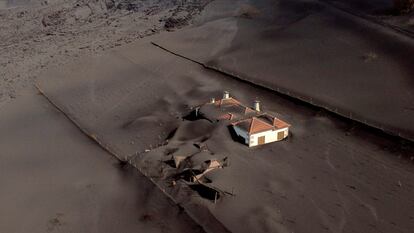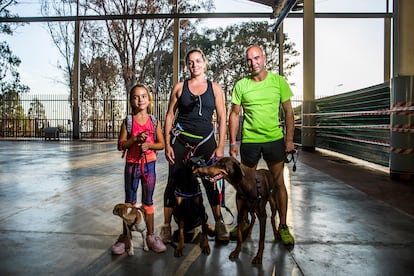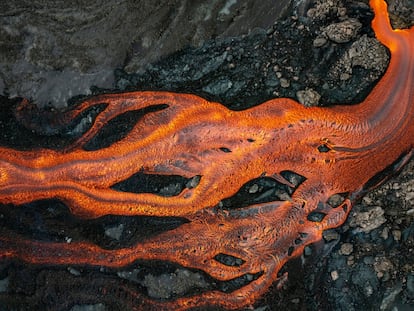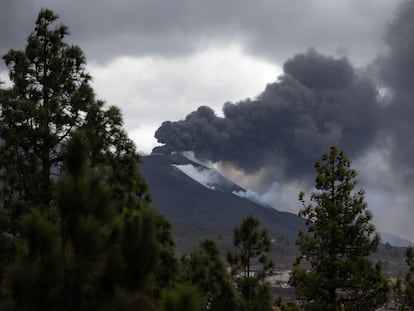Concerns remain as La Palma volcanic eruption ends: ‘The post-volcano will be tougher than the volcano’
The end of the activity on the Canary Island, which was officially declared on Saturday, has prompted relief among citizens. But with thousands left homeless, residents are facing an uncertain future

The surface of La Palma continues to burn and emit steam and gases, 10 days after the new volcano there finally went quiet. These after-effects are a reminder of the hell that was unleashed on the Canary Island between September 19 and December 13 – 85 days and eight hours of “tragedy,” according to the president of La Palma’s island council, Mariano Hernández Zapata. The longest eruption in the history of the island, and the most destructive in the last century in Europe, was finally declared over by experts on Christmas Day. But the worst could still be yet to come.
“The volcano has stopped erupting, yes. But this news has caused me a feeling of uncertainty,” explains Davinia González, a beautician who, on September 28 – the same day that the lava from the new volcano reached the sea – lost her house to the molten rock in Todoque, part of the municipality of Los Llanos de Aridane. Just a month later, the homes of both her parents and her brother saw the same fate. “I ask myself what is going to happen to us once the volcano is no longer erupting and we are no longer important news for the media. Sadness, anxiety… I don’t know, it’s hard for me to describe it.”
This is despite the fact that González can think herself relatively lucky: she was one of the first citizens to receive an apartment acquired by the Canary Islands’ regional government for the victims of the eruption – in her case, in the municipality of Tazacorte. But she can’t help looking back. During the last month she has purchased furniture for her new home, but she did so without any enthusiasm. “It’s not my house, and it will be difficult for it to be so,” she complains.
Like so many others, she is going to have to reinvent her life after this annus horribilis on La Palma. As well as the eruption, the municipality of El Paso – where the volcano was located – also suffered a fire in the summer that razed 800 hectares of land.
The feeling of abandonment suffered by González is a common one among the locals, after 85 days during which the lava flows covered 1,219 hectares of land. There are few people who have not been directly affected, or who at least know a relative or friend who owns one of the 1,576 properties that were destroyed by the molten rock, according to property records.

Stories such as those of González can be heard all over the island. María de los Ángeles, or “Chángeles” as she is known by her neighbors, has been relying on Casa Massieu these last weeks. Here, the government has installed an attention center for citizens. Chángeles, 71, also lived in Todoque, together with her husband and close by to her five children. All of them have lost everything. “I lived in a small house with a plot of land…” she explains. “It was all very humble, that’s true, but I was very happy. I was rich, and I didn’t know how to appreciate it,” she says. “My life is already coming to its end. The truth is, I feel worst for my children and my five grandchildren,” she explains, before bursting into tears.
Davinia Viña and Adolfo Pais also lived in Todoque. He worked in construction, but she worked in a banana plantation located two blocks from her home and that has also completely disappeared. “I haven’t slept for many nights,” Pais explained recently, “and I couldn’t relax until I could confirm that it was still standing.” Her home, in which she lived for 15 years, resisted for 49 days. But in the end, just when the eruption concluded, it succumbed to the lava. “We cannot fight against nature,” she accepted with resignation on Saturday.
The luckiest people are those who suffered just the anxiety of one of the 10 evacuations on the island during the eruption, or the fears caused by some of the 9,000 earthquakes felt by residents of the island, as well as some on neighboring Tenerife and El Hierro islands. The evacuees will still have to wait some time before they return home. “This will not be an immediate process,” explain sources from the emergency response. “We need to be patient. At least we have taken the first step, which is for the eruption to finish.”

Mistrust of aid
The public administrations have this month promised all kinds of aid in order to ensure the island has a future. Currently, there are still more than 7,000 people who remain evacuated. Of these, 2,329 have been directly affected given that they live in the foothills of the 200-meter cone that was born from the volcano in the Cumbre Vieja Natural Park. This Saturday saw the authorities take the opportunity to restate their promises.
The Spanish prime minister, Pedro Sánchez of the Socialist Party (PSOE), wrote via Twitter: “We will continue to work together, all of the institutions, in order to relaunch the wonderful island of La Palma and repair the damage that has been done.” The leader of the regional government, Ángel Víctor Torres, celebrated the end of the volcanic eruption and stated that the rebuilding of the island would be tackled with the utmost speed and all kinds of guarantees. “Now we are facing the true start of the reconstruction,” he said. “Our commitments remain – 2022 will be a better year.”
El mejor regalo de Navidad.
— Pedro Sánchez (@sanchezcastejon) December 25, 2021
Todo mi reconocimiento a los palmeros y palmeras. Seguiremos trabajando juntos y juntas, todas las instituciones, para relanzar la maravillosa isla de La Palma y reparar los daños ocasionados.https://t.co/fbia6FsSQG
There is, however, mistrust among the people of La Palma. One of the victims’ platforms has organized a demonstration for today, Monday, to demand “the immediate distribution of donations and aid,” as well as the “efficient and fast management of the problem of accommodation.”
Speaking several days ago, Juan Morín, the spokesperson for an organization called the Platform of Victims of the 2021 Cumbre Vieja Volcano, warned that the “post-volcano will be tougher than the volcano.” “Assistance?” asked Davinia González. “What do you want me to say. All I’ve received was something from the council. As for the state aid, I am not hopeful at all, to be honest. I don’t trust them.”
That said, there is still room for optimism in La Palma. Davinia Viña has lost everything, apart from her family. That is why she will press on with her life. “I’ll create a home somewhere else with my family, with lots of love and giving thanks to God for another day of my life,” she said on Saturday, via a WhatsApp message. “Now more than ever I want to live, and not just survive. To live.”
Tu suscripción se está usando en otro dispositivo
¿Quieres añadir otro usuario a tu suscripción?
Si continúas leyendo en este dispositivo, no se podrá leer en el otro.
FlechaTu suscripción se está usando en otro dispositivo y solo puedes acceder a EL PAÍS desde un dispositivo a la vez.
Si quieres compartir tu cuenta, cambia tu suscripción a la modalidad Premium, así podrás añadir otro usuario. Cada uno accederá con su propia cuenta de email, lo que os permitirá personalizar vuestra experiencia en EL PAÍS.
¿Tienes una suscripción de empresa? Accede aquí para contratar más cuentas.
En el caso de no saber quién está usando tu cuenta, te recomendamos cambiar tu contraseña aquí.
Si decides continuar compartiendo tu cuenta, este mensaje se mostrará en tu dispositivo y en el de la otra persona que está usando tu cuenta de forma indefinida, afectando a tu experiencia de lectura. Puedes consultar aquí los términos y condiciones de la suscripción digital.
More information
Últimas noticias
Most viewed
- David King, chemist: ‘There are scientists studying how to cool the planet; nobody should stop these experiments from happening’
- Mexico completes its trade shift with the entry into force of tariffs on China and countries without trade agreements
- Reinhard Genzel, Nobel laureate in physics: ‘One-minute videos will never give you the truth’
- Oona Chaplin: ‘I told James Cameron that I was living in a treehouse and starting a permaculture project with a friend’
- Sinaloa Cartel war is taking its toll on Los Chapitos











































